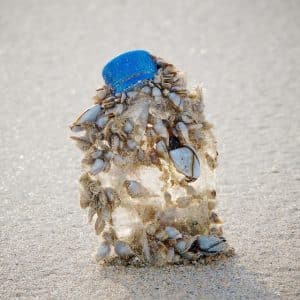This photograph of my kitchen cupboard was taken three years ago, which is really where Rag and Bone began. The beachcombed finds are mainly natural – among them pink sea fans, sea urchins, an anglerfish jawbone – and were collected while I was writing my first two books.

Increasingly though, I’d found myself picking up more of the man-made finds, most of them plastic. A favourite was the black Lego dragon on the middle shelf, lost at sea in a container spill in 1997 and found two decades later on a Cornish beach.
At the time, as well as beachcombing, I was also mudlarking on the Thames on occasional visits to London, where I was born. As the fine Thames mud is such a wonderful preserver, my foreshore finds ranged from medieval jug handles and Georgian buttons to bone combs and the mouths of delicate mouth-blown apothecary vials.

Prompted by my growing collection of discarded shore finds, I kept returning to a branch of my family that included dustmen and scavengers. I knew that over the generations they’d moved downriver from Water Street beside the Thames in central London, out to the estuary and eventually the sea. For someone keen to spend as much time as possible searching the shore, this suggested an irresistible route.
I began to sketch out an idea. From the objects I found on a series of shore walks, I would trace a history of consumption through what we’ve thrown away.

Three years later (now several months ago) this bound proof of Rag and Bone arrived: pre-virus, so it feels like another age. The previous day I’d dug out the bent spoons that made it onto the cover, and in the photograph the proof sits on several trays of unsorted shore finds. Looking back at it now, I can see Georgian clay pipes, a rusted circuit board, a silver sugar bowl lid, a hair curler and brass watering can rose, a ceramic leg and a plastic shark.
Unsurprisingly, trying to make sense of it all has been quite a journey. The walks took a year and it felt oddly appropriate that by the end of winter, the Thames finds I’d hauled back from previous centuries were swamped by beach plastic. Time and again, I caught myself thinking how astonished my dustman grandad would be at the contents of our bins today.
Over the coming months, when I would otherwise have been out giving book talks with a peculiar suitcase, I’ll use this blog to introduce some of my finds and the stories behind them.
.

To share the post:


